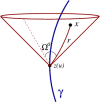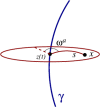The Motion of Point Particles in Curved Spacetime
- PMID: 28179866
- PMCID: PMC5256043
- DOI: 10.12942/lrr-2004-6
The Motion of Point Particles in Curved Spacetime
Abstract
This review is concerned with the motion of a point scalar charge, a point electric charge, and a point mass in a specified background spacetime. In each of the three cases the particle produces a field that behaves as outgoing radiation in the wave zone, and therefore removes energy from the particle. In the near zone the field acts on the particle and gives rise to a self-force that prevents the particle from moving on a geodesic of the background spacetime. The self-force contains both conservative and dissipative terms, and the latter are responsible for the radiation reaction. The work done by the self-force matches the energy radiated away by the particle. The field's action on the particle is difficult to calculate because of its singular nature: The field diverges at the position of the particle. But it is possible to isolate the field's singular part and show that it exerts no force on the particle - its only effect is to contribute to the particle's inertia. What remains after subtraction is a smooth field that is fully responsible for the self-force. Because this field satisfies a homogeneous wave equation, it can be thought of as a free (radiative) field that interacts with the particle; it is this interaction that gives rise to the self-force. The mathematical tools required to derive the equations of motion of a point scalar charge, a point electric charge, and a point mass in a specified background spacetime are developed here from scratch. The review begins with a discussion of the basic theory of bitensors (Section 2). It then applies the theory to the construction of convenient coordinate systems to chart a neighbourhood of the particle's word line (Section 3). It continues with a thorough discussion of Green's functions in curved spacetime (Section 4). The review concludes with a detailed derivation of each of the three equations of motion (Section 5).
Figures










References
-
- Alvi K. Approximate binary-black-hole metric. Phys. Rev. D. 2000;61:124013-1–124013-19. doi: 10.1103/PhysRevD.61.124013. - DOI
-
- Barack L. Self-force on a scalar particle in spherically symmetric spacetime via mode-sum regularization: Radial trajectories. Phys. Rev. D. 2000;62:084027-1–084027-21.
-
- Barack L. Gravitational self-force by mode sum regularization. Phys. Rev. D. 2001;64:084021-1–084021-16.
-
- Barack L, Burko L. Radiation-reaction force on a particle plunging into a black hole. Phys. Rev. D. 2000;62:084040-1–084040-5.
-
- Barack L, Lousto CO. Computing the gravitational self-force on a compact object plunging into a Schwarzschild black hole. Phys. Rev. D. 2002;66:061502-1–061502-5.
Publication types
LinkOut - more resources
Full Text Sources
